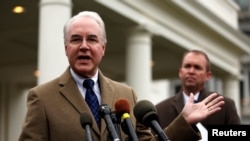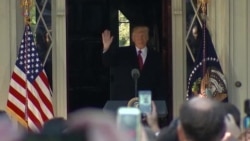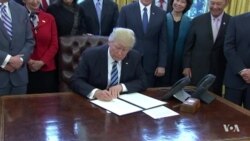The first 100 days of an American president’s first term in office traditionally are a time when the new administration’s major policy proposals might encounter less partisanship from lawmakers on Capitol Hill, and possibly even have a head start on being voted into law.
That’s particularly true when the president’s party controls both houses of Congress, as is currently the case. But at this point, about two months after the inauguration, things have not gone so easily for President Donald Trump.
From health care to the federal budget to immigration, Trump’s biggest proposals have run into major obstacles in Congress and the courts. It’s a trend that contradicts Trump’s frequent assertion that he has achieved more in two months than any other president in American history.
“It’s not actually going particularly well,” said Larry Sabato, a political analyst at the University of Virginia. “The president has not scored any easy victories on big things.”
Travel ban
The latest roadblock came Wednesday, when a federal judge blocked Trump’s new executive order to halt the U.S. refugee program temporarily and bar travelers from six Muslim-majority countries from entering the United States. The restraining order was issued hours before Trump’s new immigration rules were to take effect.
It was the second time that courts have thwarted Trump’s attempts to implement immigration restrictions (an earlier, more sweeping travel ban was blocked by a different judge last month), and it set up a potentially lengthy legal battle in the months ahead.
Trump has vowed to fight hard to reinstate the ban, promising to take the case to the Supreme Court, if necessary. But it’s not likely a battle he wanted, especially when his team is struggling to make progress on so many other fronts.
“They’re going from fire to fire to fire. And a lot of these fires have been set by themselves,” said Evan Siegfried, a Republican strategist and political commentator. “It doesn’t seem like the White House even has a long-term strategy here.”
Health care
Many lawmakers within Trump’s own Republican Party don’t support his biggest proposals, including his plan to repeal and replace former President Barack Obama’s signature health care law.
Trump built his political campaign last year around a promise to undo Obamacare, as he prefers to call the Affordable Care Act of 2010.
However, the repeal-and-replace campaign by Trump and Republican leaders on Capitol Hill has so far failed to gain much traction. And they suffered a major blow this week when the nonpartisan Congressional Budget Office estimated that Trump’s proposed replacement bill would result in 24 million Americans losing their medical insurance by 2026.
Watch: White House 2018 Budget Draws Mixed Reactions
Federal budget
Another major plank in Trump’s campaign platform was a sharp cutback in government spending. A preliminary version of the president’s budget proposal was released Thursday, greeted by widespread criticism from members of both major political parties.
The Trump spending plan calls for one of the biggest increases in military spending ever, with most of those costs coming from a significant reshaping of the federal government — budget reductions so steep that many Cabinet departments would have to suspend or eliminate programs that provide assistance to Americans living near the poverty line.
The opening salvo in what looms as a budget war between Congress and the president also calls for the elimination of almost all U.S. foreign aid.
The budget must be approved by Congress, of course, and full details will only be released in the weeks to come. Key lawmakers, however, have let it be known that the plan as Trump presented it Thursday is essentially “dead on arrival.”
Trump has said his budget and his health care proposals are simply the first stage in negotiations, and that he expects back and forth between lawmakers before any agreement is reached. But the billionaire ex-businessman, who portrays himself as a master dealmaker, has failed to bridge many of the divides.
No 'Trump caucus'
The problem is exacerbated by the fact that Trump’s positions don’t align perfectly with either party, leaving him few allies in Congress who support his entire agenda. Republican strategist Siegfried says: “There is no ‘Trump caucus.’ Nobody’s running as a Trump Republican right now.”
In addition, some potential Trump allies have been alienated by the president’s unorthodox communications style. That includes lawmakers from both parties, whom Trump regularly assails in his Twitter feed, and the news media, regularly denounced by the president as “the enemy of the people.”
Trump is pressing his agenda at a time when public opinion surveys give him unusually low favorability ratings. An average of polls compiled by RealClearPolitics ((www.realclearpolitics.com )), a news group considered nonpartisan, shows 43 percent of Americans approve of Trump’s job so far, a rating much lower than that of other presidents during their first months in office.
Watch: Two Months in, Major Parts of Trump's Agenda Stalled
Some successes
But it’s not all bleak for Trump, who remains hugely popular among Republican voters.
His pick of Neil Gorsuch for the Supreme Court was widely praised by conservatives, as were his decisions to eliminate many government regulations and reauthorize construction of oil pipelines that had been hold because of environmental concerns.
At a campaign-style rally this week, Trump pointed to how the U.S. economy has continued to add jobs since he took over the White House. He also won cheers from supporters for pulling the U.S. out of the Trans-Pacific Partnership free-trade deal, which he said would have hurt U.S. workers.
“We have done far more, I think maybe more than anybody’s done in this office in 50 days, that I could tell you,” Trump told an enthusiastic crowd Wednesday evening in Nashville, Tennessee. “And we’ve just gotten started.”

















